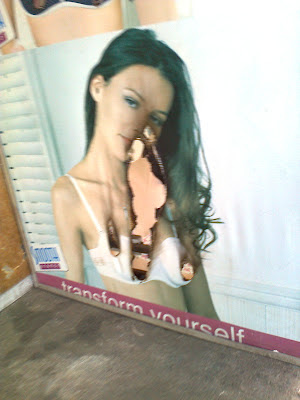Any reader
of feminist history must have come across the term “bra burners” and the
related assumptions and myths. All of us know that nothing was burnt, and the
iconic title of the protest is a reference to the onset of feminist
proclamation of freedom at the 1968 Miss America beauty pageant. Though mistaken
and misinterpreted, the issue remained in the history of human memory as a
strong demonstration of feminist assertion.
But the other day, I had to witness another kind of bra-burning here in the city of Hyderabad. The modern burners were not photographed and nobody talked about them. They burned bras behind the shadows of the night, so that no one could see them. Probably, even if it was done in bright daylight, they wouldn’t be seen or heard by us and those around- us!
You can
have a look at what and how they burned.
 |
Done by
some miscreants at Himayatnagar, Hyderabad
|
I see these
burnt advertisements on my morning walks to Husain Sagar, Hyderabad. I kept
thinking of the degree of intolerance and perversion represented by these
burned images. It was a week ago that I decided to click pictures of this burning and
write something on it. I wanted to protest. I wanted to protest the attitude
behind this burning. I didn’t feel it was funny. Neither did I feel any joy in
looking at these burnt images.
There is
something more grave than the obvious, that works behind this burning. It is not one
person’s momentary craze that inspired this action. It is a
reflection of age-old prejudices and contempt towards feminine body- a
masculine attempt to de-divinize the physical form of the opposite sex. Therefore
I wanted to register my protest. I don’t know if this would be interpreted in ways
I haven’t imagined. It doesn’t matter.
My anger overtakes me, whenever I begin to write on this, and my wit goes for a toss! Ah! But I have to write. And thus writes Sajit.
There was this jealous, incompetent, patriarchal notion that the feminine is the weaker of the two genders, from the beginning of times (I guess). And to compensate the obviously negative connotation, the ‘strong’ gender added that the weak gender was also ‘gentle and fairer’. Very funny. But jealousy did not stop there. It takes different forms. The ‘gentle ones’ are kept at home to be rotten, uneducated, and unequal. They were not given enough (and equal) opportunities to grow and were not treated well during the day, and ill-treated during the night. The last in the list is a difficult logic, but easy to understand. It is the way gender jealousy works.
 |
| Drunk or mad? |
Women have
stronger immunity systems, faster reflex and deeper intuitions. Very natural, eloquent,
and graceful. Jealousy goes a step higher on the ladder. If both the genders
were given equal opportunities in a neutral world, on a competitive basis, the results for sure would have been quite different. Therefore, the muscled gender found ways, concocted reasons, invented traditions, and
established taboos to prove that the non-muscled
and gentle gender ought to be kept
under powerful masculine control! Not finished- these notions are institutionalized
with the help religion, culture and politics. Wonderful, isn't it?
Now, to keep things under control, more customs, stranger traditions, etc. are bought in. But what if thing go out of control? Ah, there are ways to manage this. Modern bra burning is one such. Mock. Laugh at. Look down upon. Let contempt come from within the enemy. Let destruction be complete. If these measures do not work, there are more in the list. Insult, rape, torture, molestation, blackmail, murder, honour killing, public stripping and beatings, etc. are just a few.
Therefore WE continue to burn. And
the rest of US continue to witness in silence. They say our traditions are god-given and
therefore eternal, and therefore holy! If we don't change our mindset, we will be remembered as the land where cows roam legally protected while women are brutally objectified and eliminated. If we decide to turn away from such images, we will remain blinded. All of us will!


